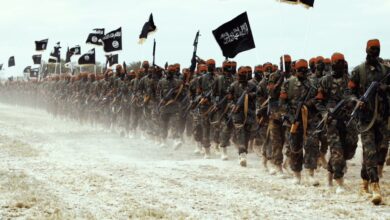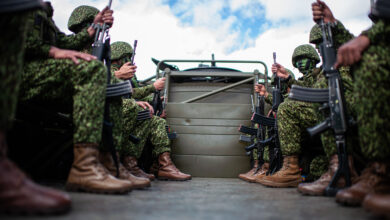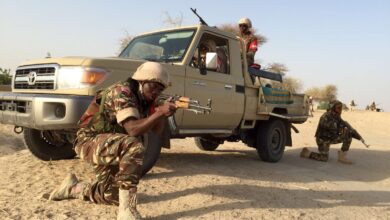Northern Ireland police recover mortar ‘component’ in Castlewellan after day-long operation
Police in Northern Ireland said late Thursday they had recovered part of a mortar after a day-long search in Castlewellan near the border with Ireland.
A member of the public first discovered the component on the Priests road outside the County Down town late Wednesday evening, the BBC reported.
“Our initial assessment is whilst this was not a viable device, it is clear that this is a component that could have been part of something more sinister,” Detective Inspector Graham Orr from the Police Service of Northern Ireland Terrorism Investigation Unit said on September 19.
Orr did not give additional details on the nature of the component but a photograph appeared to show an improvised mortar shell in a stone wall.
The discovery comes just months after police recovered a horizontal mortar tube and command wire during an operation near Castlewellan. PSNI Detective Inspector John McVea said at the time that investigators believed that device was left behind a wall at the side of the road for another person to collect and was not for an attack.
However, a number of devices uncovered lately are believed to have been intended to target Northern Ireland police, including an improvised explosive device found in the Creggan area of the city of Derry earlier this month, a few hours’ drive west of Castlewellan.
Dissident Irish republicans opposed to the peace process in Northern Ireland are believed to be behind the incidents.
The search in Creggan on September 10 came in response to the discovery of a horizontal mortar near a house in nearby Strabane, a day earlier and less than a mile from the Northern Ireland-Ireland border.
Police in Northern Ireland and Ireland have said that a return to a hard border on the island of Ireland after Brexit could result in an increase in attacks by militant groups.
No group has said it was responsible for the Castlewellan device found Thursday and police said it was too early to attribute the device found in April to a specific organization. The largest dissident Irish republican group, known as the New IRA, is believed to be responsible for the Derry and Strabane devices as well as a number of other incidents.
In April, the New IRA admitted shooting to death journalist Lyra McKee during rioting in the Creggan area of Derry. McKee was shot on April 18 by an unknown gunman who was firing at police in the city, also known as Londonderry. She later died from her injuries in hospital.
The rioting that killed McKee broke out as police were trying to carry out searches in connection with dissident activity.
In January, a car bomb exploded outside a courthouse in Derry, an attack also blamed on the New IRA.
Last month police escaped injury when a device exploded near Newtownbutler about 55 miles (88 km) south of Strabane, and about a mile from two separate border crossings. Police had been called to the Wattle Bridge area of County Fermanagh over a hoax bomb and were investigating it when a second device detonated.
Deputy Chief Constable Stephen Martin said the New IRA and another dissident Irish republican group called the Continuity IRA “would be a very good starting point for the investigation” into the Wattle Bridge explosion.
The Continuity IRA is believed to be responsible for another bomb in Craigavon in County Armagh on July 26.
In that incident, the Irish News received a telephone call claiming that a “horizontal mortar was fired at a passed police patrol” on the Tullygally Road but had “missed its target,” and that left “a warhead in the vicinity.”
Police later discovered what appeared to be a horizontal mortar that had been fired, but on examination, a viable booby-trap bomb was found hidden inside a concrete block beside a metal tube.
Since the January car bomb, a number of weapons caches have been uncovered in the southeast of Northern Ireland and just across the border in Ireland.
On March 6, the PSNI uncovered what they called a “significant terrorist hide” of mortar parts, including tubes, in a forested area near Forkhill close to the border, around 40 km (25 miles) west of Castlewellan.
A week prior, police uncovered a “sizeable” quantity of ammunition during a search near Omeath in County Louth as part of a follow-up operation targeting the activities of dissident Irish republican groups after Gardaí (Irish police) found a mortar tube and a “substantial” quantity of ammunition in the area on February 1.
Dissident Irish republicans have also taken credit for a series of explosive devices sent to Great Britain in March, with the New IRA claiming they sent four mail bombs that were recovered in London and Glasgow. A fifth “viable device” was discovered at the National Returns Letter Centre in Limerick after it had been returned by the postal service from the United Kingdom.
The 1998 Good Friday or Belfast Agreement ended what is known as The Troubles, three decades of violence in Northern Ireland beginning in the late 1960s in which more than 3,500 people were killed, the majority by predominantly Catholic Irish republicans who want the reunification of Ireland, but also by mainly Protestant loyalists who want Northern Ireland to remain part of the United Kingdom, as well as by the security forces.
The violence also spilled over into Ireland, the United Kingdom mainland, and Europe.
The Provisional Irish Republican Army called a final ceasefire in 1997 and announced an end to its armed campaign in 2005, stating that it would seek to achieve its aims through peaceful political means. Various dissident Irish republican groups opposed to the peace process split from the Provisionals and continued to use the name IRA. There had been sporadic violent incidents since the 1998 Good Friday agreement until the apparent uptick in activity over the past year.












